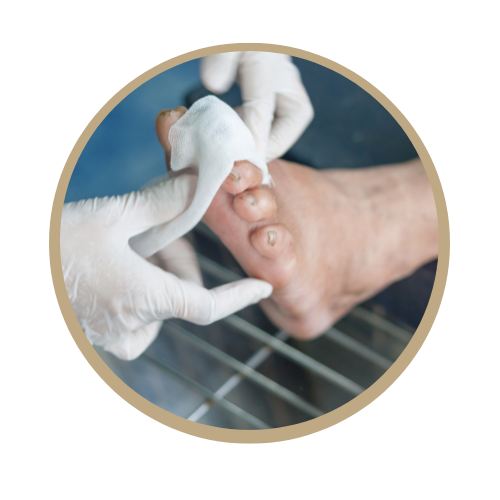Ancaster Foot Fixer and Orthotics Clinic
Diabetic Wound Care
Diabetic Wound Care
Diabetic wound care is a critical aspect of managing diabetes, as individuals with diabetes are at an increased risk of developing foot ulcers and other wounds. Diabetes can affect the nerves and blood vessels in the feet, leading to reduced sensation (neuropathy) and impaired circulation. Proper wound care is essential to prevent complications, including infections and more severe issues that can arise from poorly healing wounds. Here's an overview of diabetic wound care:
1. Daily Foot Inspection:
- Importance: Individuals with diabetes should inspect their feet daily for any signs of wounds, cuts, blisters, redness, or changes in skin color.
-
Action Steps:
- Use a mirror or ask for assistance to inspect the bottom of the feet.
- Check between toes and other areas that may be difficult to see.
2. Cleanliness and Hygiene:
- Importance: Keeping the feet clean helps prevent infections.
-
Action Steps:
- Wash feet daily with mild soap and lukewarm water.
- Gently dry the feet, especially between toes, and avoid excessive moisture.
3. Moisturizing:
- Importance: Preventing dry skin helps reduce the risk of cracks and fissures.
-
Action Steps:
- Apply a moisturizing cream or lotion, excluding the areas between toes.
- Avoid applying lotion between toes to prevent excess moisture.
4. Proper Nail Care:
- Importance: To prevent ingrown toenails and other issues.
-
Action Steps:
- Trim toenails straight across and file the edges.
- Seek professional help for nail care if needed.
5. Protective Footwear:
- Importance: To prevent injuries and pressure points.
-
Action Steps:
- Wear well-fitting, comfortable shoes with ample toe room.
- Avoid walking barefoot, even at home.
6. Avoiding Extreme Temperatures:
- Importance: To prevent burns or frostbite.
-
Action Steps:
- Check water temperature before bathing.
- Protect feet from extreme cold or heat.
7. Regular Foot Exams by Healthcare Professionals:
- Importance: Regular check-ups can identify issues early.
-
Action Steps:
- Schedule regular foot exams with a podiatrist or healthcare provider.
8. Management of Blood Sugar Levels:
- Importance: Good blood sugar control supports overall health and wound healing.
-
Action Steps:
- Follow a diabetes management plan as prescribed by healthcare providers.
9. Immediate Attention to Wounds:
- Importance: Quick action can prevent complications.
-
Action Steps:
- Clean cuts or wounds with mild soap and water.
- Apply an antiseptic ointment and a sterile dressing.
- Seek medical attention for any wound that doesn't heal.
10. Foot Elevation:
- Importance: Elevation can reduce swelling.
-
Action Steps:
- Elevate feet when sitting or lying down, especially if there is swelling.
11. Regular Exercise:
- Importance: Promotes circulation and overall foot health.
-
Action Steps:
- Engage in activities recommended by healthcare providers.
15. Custom Orthotics:
- Importance: Can help offload pressure points and promote proper foot alignment.
-
Action Steps:
- Consider custom orthotics as recommended by a podiatrist.
Individuals with diabetes should work closely with their healthcare team, including Chiropodist to create a personalized foot care plan. Regular monitoring, education, and prompt intervention are key components of effective diabetic wound care. Any concerns or signs of complications should be addressed promptly to prevent more severe issues.


